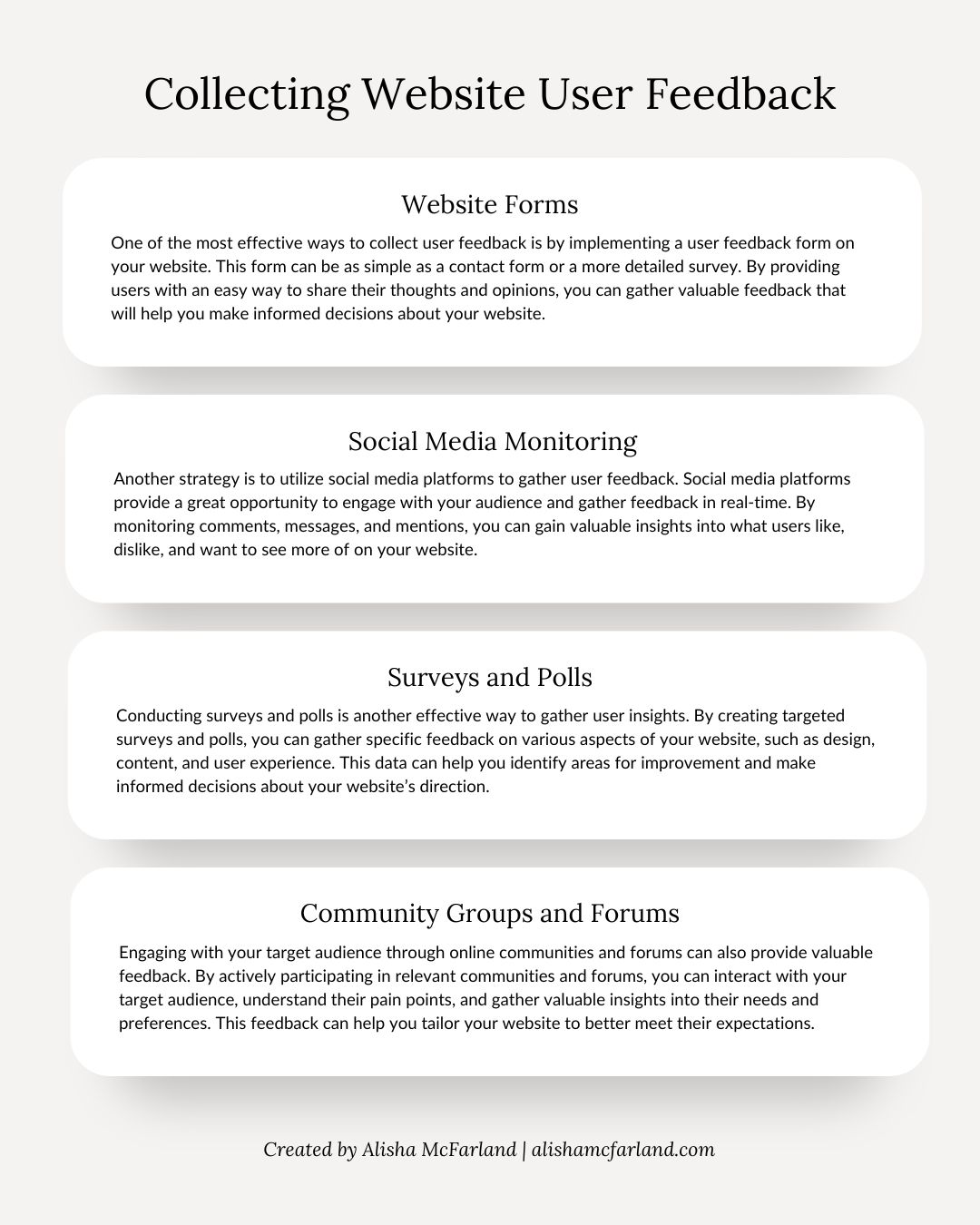Are you a new website owner looking to improve user engagement and understand your target audience better? Look no further! In this article, I will reveal five strategies that will help you collect valuable user feedback and gain valuable insights into your website’s audience.
Understanding your target audience is essential for any website to succeed. By gathering user feedback, you can uncover what your audience wants, needs, and expects from your site. This valuable information will allow you to refine your website, create more relevant and engaging content, and ultimately increase user satisfaction and conversion rates.
The Importance of Collecting User Feedback for New Websites
As a new website owner, you may have a vision for your site, but it’s important to remember that your target audience will ultimately determine its success. By gathering user feedback, you can gain valuable insights into what your audience wants, needs, and expects from your website.
Website Forms
One of the most effective ways to collect user feedback is by implementing a user feedback form on your website. This form can be as simple as a contact form or a more detailed survey. By providing users with an easy way to share their thoughts and opinions, you can gather valuable feedback that will help you make informed decisions about your website.
Social Media
Another strategy is to utilize social media platforms to gather user feedback. Social media platforms provide a great opportunity to engage with your audience and gather feedback in real-time. By monitoring comments, messages, and mentions, you can gain valuable insights into what users like, dislike, and want to see more of on your website.
Surveys and Polls
Conducting surveys and polls is another effective way to gather user insights. By creating targeted surveys and polls, you can gather specific feedback on various aspects of your website, such as design, content, and user experience. This data can help you identify areas for improvement and make informed decisions about your website’s direction.
Forums
Engaging with your target audience through online communities and forums can also provide valuable feedback. By actively participating in relevant communities and forums, you can interact with your target audience, understand their pain points, and gather valuable insights into their needs and preferences. This feedback can help you tailor your website to better meet their expectations.
Website Analytics
Monitoring website analytics is another important strategy to collect user feedback. By analyzing user behavior and preferences, you can gain insights into how users interact with your website. This data can help you identify areas of improvement, such as high bounce rates or low conversion rates, and make informed decisions to optimize your website’s performance.
Collecting user feedback is an ongoing process that requires continuous effort. By implementing these strategies and actively listening to your audience, you can gather valuable insights that will help you refine your website and better serve your target audience.
Common Mistakes to Avoid When Collecting User Feedback
Collecting user feedback is a valuable process that can provide you with valuable insights into your target audience. However, there are common mistakes that website owners often make when collecting user feedback that can hinder the effectiveness of the process. By being aware of these mistakes, you can avoid them and ensure that you collect accurate and actionable data.
Neglecting Qualitative Feedback
One common mistake is relying solely on quantitative data and neglecting qualitative feedback. While quantitative data, such as website analytics and survey responses, can provide valuable insights, qualitative feedback can offer a deeper understanding of your audience’s needs and preferences. By incorporating open-ended questions and encouraging users to provide detailed feedback, you can gather qualitative data that complements quantitative findings.
No Follow Up
Another mistake is failing to follow up with users after collecting feedback. User feedback is only valuable if it leads to action and improvement. By failing to follow up with users and communicate how their feedback has been used to make changes, you risk losing their trust and engagement. Ensure that you communicate with your users and show them that their feedback is valued and has a direct impact on your website’s development.
Leading and Biased Questions
It’s also important to avoid leading questions or bias in surveys and feedback forms. Leading questions can influence users’ responses and skew the data you collect. Ensure that your questions are neutral and unbiased, allowing users to provide their honest opinions and insights.
Small Sample Sizes
Another common mistake is collecting feedback from a limited sample size or a non-representative group. To gather accurate and reliable data, it’s important to collect feedback from a diverse range of users who represent your target audience. This will ensure that the feedback you receive is representative of your entire user base.
Making Assumptions
Lastly, it’s essential to avoid making assumptions based on user feedback without validating them. While user feedback is valuable, it’s important to test and validate any assumptions or changes based on that feedback. User testing and A/B testing can help you ensure that the changes you make are effective and well-received by your audience.
By avoiding these common mistakes, you can ensure that the user feedback you collect is accurate, actionable, and leads to meaningful improvements on your website.
Tools and Resources for Collecting and Analyzing User Feedback
Collecting and analyzing user feedback can be a complex process, but there are numerous tools and resources available to help you streamline the process and gain valuable insights. Here are some tools and resources that can assist you in collecting and analyzing user feedback effectively:
SurveyMonkey
SurveyMonkey is a popular online survey tool that allows you to create and distribute surveys to gather user feedback. It offers a range of question types, survey templates, and reporting features to help you collect and analyze data easily. With SurveyMonkey, you can gather both quantitative and qualitative feedback to gain a comprehensive understanding of your audience.
Google Analytics
Google Analytics is a powerful web analytics tool that provides detailed insights into user behavior on your website. It allows you to track key metrics such as page views, bounce rates, and conversion rates, helping you identify areas for improvement and optimization. By analyzing user behavior, you can gain valuable insights into how users interact with your website and make data-driven decisions to enhance the user experience.
Hotjar
Hotjar is a user behavior analytics and feedback tool that combines features such as heatmaps, session recordings, and feedback polls. Heatmaps visualize user interactions, showing you where users click, scroll, and spend the most time on your website. Session recordings allow you to watch users’ interactions with your website in real-time, helping you identify pain points and areas for improvement. Feedback polls enable you to gather user feedback directly on your website, making it easy for users to share their thoughts and opinions.
UserTesting
UserTesting is a user research platform that allows you to conduct remote user testing sessions. It enables you to observe users as they navigate and interact with your website, providing valuable insights into their user experience. Through UserTesting, you can create tasks for users to complete, record their sessions, and receive detailed feedback and recommendations. This tool is particularly useful for gaining a deeper understanding of user behavior and uncovering usability issues.
Social Media Listening Tools
Social media listening tools, such as Hootsuite, Sprout Social, and Brandwatch, enable you to monitor and analyze social media conversations and mentions related to your website. These tools allow you to track keywords, hashtags, and mentions, helping you gather user feedback and insights in real-time. By monitoring social media conversations, you can identify trends, address customer concerns, and engage with your audience effectively.
These are just a few examples of the tools and resources available to help you collect and analyze user feedback. Depending on your specific needs and budget, you can explore other options and find the tools that best suit your requirements.
Take Away
Collecting user feedback and honing in on your target audience is an ongoing process that requires continuous effort and attention. By implementing the strategies discussed in this article and utilizing the tools and resources available, you can gather valuable insights, refine your website, and better serve your target audience.
Remember, collecting user feedback is not a one-time task but an ongoing process. User preferences and expectations evolve over time, and it’s essential to stay connected with your audience to meet their changing needs. By actively listening to your users, engaging with them on various platforms, and analyzing their behavior, you can continuously improve your website and stay ahead of the competition.




